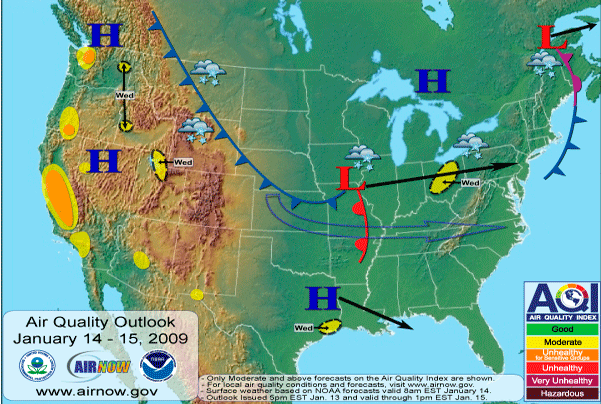| A cross-agency U.S. Government Web site. List of AIRNow partner agencies |

|
National Overview
Partners
Air Quality Basics
The AQI for...
Key Topics:
Resources |
| Contact Us |
| Privacy and Security Notice |
| Accessibility |
National Outlook for January 14-15
| Unhealthy for Sensitive Groups AQI Levels in the West | |
Wednesday, January 14 – Thursday, January 15: In the West, an upper-level ridge of high pressure over the West Coast will limit vertical mixing in the atmosphere. Furthermore, cool overnight temperatures will allow a temperature inversion to form, especially over inland areas, trapping pollutants near the surface. These conditions, combined with light winds limiting pollutant dispersion, will lead to widespread Moderate AQI levels, with some areas of western Washington, southern Oregon, and central and northern California reaching Unhealthy for Sensitive Groups AQI levels. In the East, southerly winds ahead of an approaching low-pressure system will transport moisture and pollutants northward, enhancing particle production and leading to Moderate AQI levels in portions of Ohio on Wednesday. Today's Forecast | Cities with Action Days (Air Quality Alerts) |
|
 |
|
| Health Tip: Cut back on strenuous outdoor exercise when air quality is expected to be unhealthy. Exercise during the early morning or late evening hours when ozone levels are at the lowest levels of the day. This is especially important for children and other sensitive groups. The booklet, Air Quality Index - A Guide to Air Quality and Your Health, contains information about the health effects of the five most common air pollutants, and how to avoid those effects. | |
| How You Can Help: Reduce or eliminate fireplace and wood stove use when particle pollution levels are expected to be high. Reduce vehicle use. | |
| Source: U.S. Environmental Protection Agency | |
| |
||||||||||||
|
AIRNow is a government-backed program. Through AIRNow, EPA, NOAA, NPS, news media, tribal, state,
and local agencies work together to report conditions for ozone and particle pollution.
State, Local and Tribal Partners.
|
||||||||||||
|
||||||||||||





